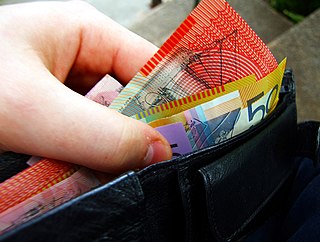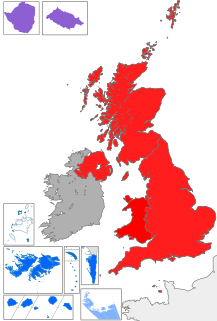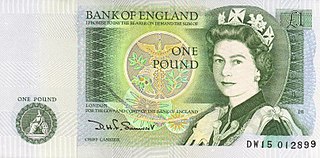Related Research Articles

The Bank of England is the central bank of the United Kingdom and the model on which most modern central banks have been based. Established in 1694 to act as the English Government's banker, and still one of the bankers for the Government of the United Kingdom, it is the world's eighth-oldest bank. It was privately owned by stockholders from its foundation in 1694 until it was nationalised in 1946.

Sterling banknotes are the banknotes in circulation in the United Kingdom and its related territories, denominated in pounds sterling.

Polymer banknotes are banknotes made from a synthetic polymer such as biaxially oriented polypropylene (BOPP). Such notes incorporate many security features not available in paper banknotes, including the use of metameric inks. Polymer banknotes last significantly longer than paper notes, causing a decrease in environmental impact and a reduced cost of production and replacement. Modern polymer banknotes were first developed by the Reserve Bank of Australia (RBA), Commonwealth Scientific and Industrial Research Organisation (CSIRO) and The University of Melbourne. They were first issued as currency in Australia during 1988. In 1996 Australia switched completely to polymer banknotes. Other countries that have switched completely to polymer banknotes include: Brunei, Canada, Maldives, Mauritania, Nicaragua, New Zealand, Papua New Guinea, Romania and Vietnam. The latest countries to introduce polymer banknotes into general circulation include: the United Kingdom, Nigeria, Cape Verde, Chile, The Gambia, Nicaragua, Trinidad and Tobago, Mexico, Botswana, São Tomé and Príncipe, North Macedonia, the Russian Federation, Armenia, Solomon Islands, Egypt, the Organisation of Eastern Caribbean States (OECS), Samoa, Morocco, Albania and Cambodia.

The Bank of England, which is now the central bank of the United Kingdom, has issued banknotes since 1694. In 1921 The Bank of England gained a legal monopoly on the issue of banknotes in England and Wales, a process that started with the Bank Charter Act of 1844 when the ability of other banks to issue notes was restricted.

The Chief Cashier of the Bank of England is the person responsible for issuing banknotes at the Bank of England and is the director of the divisions which provide the Bank of England's banking infrastructure. This person is known to the general public because since 1870 the Chief Cashier's signature is printed on all bank notes issued by the Bank of England. In 2004 a new post was created, Executive Director of Banking & Chief Cashier, incorporating the title.

The Frontier series is the seventh series of banknotes of the Canadian dollar released by the Bank of Canada, first circulated in 2011. The polymer banknotes were designed for increased durability and to incorporate more security features over the preceding 2001 Canadian Journey series. The notes feature images that focus on historic Canadian achievements and innovation. Printed on polymer, the 2011 Frontier series was the first series issued by the Bank of Canada printed on a material other than paper. The 2011 Frontier series was followed by the 2018 series.
Victoria Mary Florence Cleland was the Director for Banknotes and Chief Cashier of the Bank of England, a position she held from March 2014 until 1 June 2018 when was replaced by Sarah John. She is the second woman to hold the post of Chief Cashier. She replaced Chris Salmon when he was appointed as Executive Director for Markets at the Bank of England.
Merlyn Vivienne Lowther was Chief Cashier of the Bank of England for 1999 to 2003. She was the first woman to hold the post. The signature of the Chief Cashier appears on Bank of England banknotes. Lowther was succeeded by Andrew Bailey.
Graham Edward Alfred Kentfield was Chief Cashier of the Bank of England for 1991 to 1998. The signature of the Chief Cashier appears on British banknotes. Kentfield was replaced as Chief Cashier by Merlyn Lowther.
George Malcolm Gill was Chief Cashier of the Bank of England for 1988 to 1991. The signature of the Chief Cashier appears on British banknotes. Gill was replaced as Chief Cashier by Graham Kentfield. He was one of the shortest serving Chief Cashiers and during Gill's tenancy, two different £5 notes were issued with his signature.
David Henry FitzRoy Somerset was Chief Cashier of the Bank of England for 1980 to 1988. The signature of the Chief Cashier appears on British banknotes. Somerset was replaced as Chief Cashier by Malcolm Gill.

John Brangwyn Page was a British banking executive who served as the Chief Cashier of the Bank of England from 1970 to 1980. The signature of the Chief Cashier appears on British banknotes. Page was replaced as Chief Cashier by David Somerset.

Horace George Bowen was the Chief Cashier of the Bank of England from 1893 to 1902.

Matthew Marshall (1791–1873) was the Chief Cashier of the Bank of England from 1835 to 1864.

The Bank of England £5 note, also known as a fiver, is a banknote of the pound sterling. It is the smallest denomination of banknote issued by the Bank of England. In September 2016, a new polymer note was introduced, featuring the image of Queen Elizabeth II on the obverse and a portrait of Winston Churchill on the reverse. The old paper note, first issued in 2002 and bearing the image of prison reformer Elizabeth Fry on the reverse, was phased out and ceased to be legal tender after 5 May 2017.

The Bank of England £10 note, also known as a tenner, is a banknote of the pound sterling. It is the second-lowest denomination of banknote issued by the Bank of England. The current polymer note, first issued in 2017, bears the image of Queen Elizabeth II on the obverse and the image of author Jane Austen on the reverse. The final cotton paper note featuring a portrait of naturalist Charles Darwin, first issued in 2000, was withdrawn from circulation on 1 March 2018, thereby replacing the cotton with a material more fit for purpose.

The Bank of England £20 note is a banknote of the pound sterling. It is the second highest denomination of banknote issued by the Bank of England. The current polymer note, first issued on 20 February 2020, bears the image of Queen Elizabeth II on the obverse and the image of painter J. M. W. Turner on the reverse. It will fully replace the cotton paper note featuring a portrait of economist Adam Smith, first issued in 2007, and has now been issued on 20 February 2020.

The Bank of England £50 note is a banknote of the pound sterling. It is the highest denomination of banknote issued for public circulation by the Bank of England. The current cotton note, first issued in 2011, bears the image of Queen Elizabeth II on the obverse and the images of engineer and scientist James Watt and industrialist and entrepreneur Matthew Boulton on the reverse.

The Bank of England £1 note was a banknote of the pound sterling. After the ten shilling note was withdrawn in 1970 it became the smallest denomination note issued by the Bank of England. The one pound note was issued by the Bank of England for the first time in 1797 and continued to be printed until 1984. The note was withdrawn in 1988 in favour of the one pound coin.
The Bank of England £100,000,000 note, also referred to as Titan, is a non-circulating Bank of England banknote of the pound sterling used to back the value of Scottish and Northern Irish banknotes. It is the highest denomination of banknote printed by the Bank of England.
References
- ↑ Chief Cashiers. Archived 2014-09-24 at the Wayback Machine Bank of England. Retrieved 19 September 2014.
- ↑ Bank of England announces major reorganisation. BBC News, 18 March 2014. Retrieved 19 September 2014.